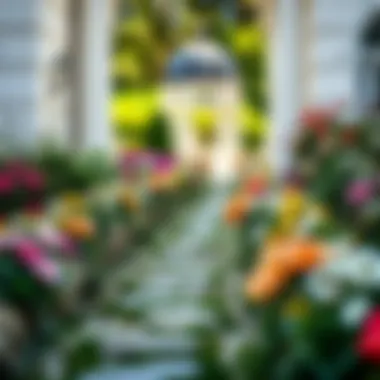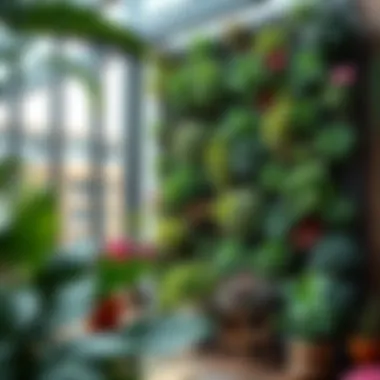Elevate Your Garden: Creative Decoration Strategies


Intro
In a world that often rushes by, the garden stands as a tranquil oasis—a patch of earth where one can connect with nature. Elevating the aesthetic appeal of your garden is not merely about the flowers or the lawn; it encompasses a broader range of elements that transform a plain outdoor space into a personal sanctuary. This extensive guide delves deeper into garden decoration strategies, unveiling the many layers that contribute to the beauty and functionality of these outdoor spaces.
The act of gardening goes beyond planting seeds or watering the lawn. It embodies a creative expression, an opportunity to showcase one's personality while interacting harmoniously with the environment. As we explore the intricacies of garden decoration, we will consider various styles, themes, and decor items that can breathe life into your outdoor space. Here, you'll find tips that seamlessly blend functionality with aesthetic value, ensuring your garden isn't just beautiful but also practical.
Whether you are a seasoned gardener or just starting to dip your toes into the world of landscape architecture, this guide aims to provide valuable insights. We will walk you through diverse decor choices, touch on sustainable practices, and ultimately help you cultivate a unique outdoor setting that speaks to your soul. So let's venture into this journey of garden enhancement, ensuring each blade of grass and flower petal sings a tune that resonates with your inner self.
Understanding Garden Decoration
Garden decoration is not just about sprinkling a few ornaments here and there; it’s about creating a vibrant, inviting space that resonates with the senses and reflects one’s personality. It serves both an aesthetic purpose and a functional role, making it imperative to understand its intricacies. Through the various layers of garden decoration, homeowners can turn an ordinary patch of land into a magnificent retreat.
Defining Garden Decoration
Garden decoration involves the arrangement and combination of elements like plants, structures, and artwork to enhance the visual appeal of outdoor spaces. A garden can be defined not only by the flowers and foliage it contains but also by the decorative features that are integral to its personality. For instance, a carefully placed bench can offer a cozy nook for contemplation, while an intricately designed pathway leads the eye and invites exploration.
In essence, garden decoration is about crafting a seamless blend of nature and artistic expression. It’s the subtle touches—like the rustic charm of weathered garden furniture or the splashes of color from a strategically placed flower pot—that can breathe life into a usually mundane landscape.
The Importance of Aesthetics
Aesthetics in garden decoration cannot be overstated. It’s what draws the eye and stirs emotion. A well-decorated garden doesn’t just look good; it tells a story, creates an ambiance, and fosters a sense of peace.
- Creates Relationships: Aesthetic appeal creates a connection between the observer and the environment. The interplay of colors, textures, and forms can evoke different moods, turning a simple garden into a sanctuary of tranquility.
- Enhances Property Value: Well-decorated gardens increase the allure of a property. Potential buyers often look for outdoor spaces that are visually appealing, as they envision themselves enjoying those moments of leisure without the hassles of urban life.
- Attracts Wildlife: Thoughtful decoration can create habitats for beneficial wildlife. Adding native flowers or water elements can attract butterflies and birds, vital for pollination and maintaining ecological balance.
Functional Aspects of Decoration
While aesthetics are crucial, functionality is equally important in garden decoration. A well-thought-out design can enhance usability and comfort, making the outdoor space more versatile.
- Define Spaces: Decorative elements such as trellises, arbors, or decorative fences can delineate different areas within a garden, such as lounging spaces, vegetable patches, or flower beds. This helps in maintaining order while still being visually appealing.
- Improve Accessibility: Strategic placement of pathways, steps, and seating ensures that the garden can be enjoyed by everyone, including individuals with mobility challenges. For example, incorporating wide, smooth pathways not only adds beauty but serves a practical purpose.
- Sustainability Practices: Using eco-friendly materials in decoration helps in maintaining an environmentally sustainable garden. Selecting local and low-maintenance plants reduces the need for excessive watering and fertilizers, contributing to a healthier ecosystem.
"A garden should be a balance of art and nature, where beauty meets practicality."
Incorporating these principles into garden decoration can transform a space from mundane to magnificent, enhancing not just visuals, but the overall experience of being outdoors.
Garden Styles and Themes
Garden styles and themes play a crucial role in the overall design and functionality of any outdoor space. The way a garden is styled can influence not only its visual appeal but also the emotional experience it offers to visitors. The right theme reflects the personality of the homeowner while catering to the specific conditions of the site, such as climate, soil type, and sun exposure. By understanding various garden styles, one can elevate their outdoor space from simply being a patch of green to a sanctuary that provides joy and relaxation.
Benefits of Understanding Garden Styles
- Personal Expression: Each style allows for individual creativity. Whether one leans towards modern minimalism or a sprawling cottage look, the chosen style speaks volumes about personal taste.
- Functional Design: Certain themes serve specific purposes. For instance, a zen garden is designed for contemplation and peace, while a tropical garden thrives on vibrancy and diversity.
- Cohesion: A well-defined theme ensures that all elements—from plants to pathways—harmonize well together creating a pleasing aesthetic.
Considerations for Choosing a Garden Style
- Climate Suitability: Certain plants and designs work better in specific climates. A lush tropical theme might not thrive well in cooler regions.
- Maintenance Level: Some styles require more care than others. For example, a Japanese garden may need regular pruning, whereas a drought-resistant native garden might be more low-maintenance.
This exploration begins with popular garden styles that can instantly transform a yard into an inviting paradise, each holding potential to create something exceptional.
Modern Garden Design
Modern garden design emphasizes clean lines and a minimalist aesthetic. It's about simplicity, utility, and often incorporates contemporary materials such as concrete and metal. The focus is on functional space and structured layouts.
Key elements include:
- Geometric Shapes: Lines and shapes dominate modern gardens, making them visually striking and orderly.
- Neutral Color Palettes: Subtle hues are usually favored to not detract from the overall clean look.
- Integration of Technology: Smart irrigation systems and energy-efficient lighting are common, enhancing sustainability and ease of use.
A modern garden stands as a testament to a homeowner’s forward-thinking approach, reflecting a lifestyle that values both form and function.
Cottage Garden Aesthetics
Cottage gardens burst with personality and charm. They typically feature a mix of flowers, vegetables, and herbs grown in an informal way. This style embraces a naturalistic look, often appearing as though it has grown over time.
Essential elements include:


- Dense Planting: Plants are grouped closely to create a lush feel and provide a splash of colors.
- Pathways: Meandering paths made from stones or gravel enhance the allure of wandering through the garden.
- Wildlife Attractions: Birdhouses and insect hotels are commonly integrated, adding to the garden’s ecosystem.
The cottage garden embodies the essence of homeliness, often reminiscent of the English countryside, offering a sanctuary that feels both welcoming and vibrant.
Zen Garden Principles
Zen gardens, or karesansui, originate from Japan and promote tranquility and meditation. They focus heavily on simplicity and the use of minimal elements to create a serene atmosphere.
Key principles include:
- Rock Arrangements: Carefully positioned rocks symbolize mountains or islands, playing a significant role in the overall composition.
- Sand and Gravel: Raked into patterns representing water or waves, these features encourage mindfulness and contemplation.
- Subdued Planting: Limited flora, often consisting of moss or carefully selected shrubs, brings balance without overwhelming sensory input.
A Zen garden integrates philosophical meaning into landscape design, offering a respite from the chaos of daily life.
Tropical Inspirations
A tropical garden evokes the lushness of exotic landscapes and often includes colorful, oversized foliage. It's all about vibrant colors and rich textures.
Key features involve:
- Diverse Plant Life: Palms, ferns, and flowering plants like hibiscus offer a dense green feel and striking blooms.
- Water Elements: Features like small ponds or fountains can enhance the humid atmosphere desired in tropical settings.
- Bold Colors: Bright flowers harmoniously clash with deep green leaves, creating a visual feast.
Incorporating tropical inspirations transports one to warmer climates and invigorates the senses, making it ideal for relaxation and enjoyment outdoors.
"Understanding these garden styles provides not just a stepping stone to beautification, but a way to embody one’s essence in the outdoor space."
In essence, selecting a style for your garden is more than mere aesthetics. It encapsulates personal values, environmental considerations, and aspirations. The diverse options available offer opportunities not just to beautify one's surroundings but to foster a personal retreat that resonates deeply.
Key Decorative Elements
In the realm of garden decoration, the concept of key decorative elements encompasses various physical and conceptual components that can significantly enhance both the visual appeal and functionality of an outdoor space. These elements not only contribute to the ambiance but also serve practical purposes, creating an inviting atmosphere for anyone who steps into your garden. By thoughtfully selecting and arranging these elements, you can transform a simple yard into a stunning sanctuary that reflects personal taste and fosters connection with nature.
Focal Points in the Garden
Focal points are the standouts in your garden design, drawing the eye and providing a sense of structure. Whether it’s a stunning sculpture, an unusual plant, or a striking water feature, a well-placed focal point can anchor the garden, creating balance and attracting attention.
When designing your focal points, consider the scale and placement. A towering obelisk may dominate a small space, while a delicate birdbath might get lost in a large yard. Think about your garden’s lines and pathways – how will visitors naturally flow through the space? Connecting elements that guide the eyes towards your focal points can enhance their impact.
Tips for Creating Impactful Focal Points:
- Choose Unique Pieces: Select items that resonate personally or have a backstory.
- Incorporate Color and Texture: Bold colors or engaging textures can make your focal point pop.
- Use Height Variations: Layering different heights creates visual intrigue.
"A garden without a focal point is like a narrative without a plot; it's harder for visitors to grasp the story you're telling."
Lighting Solutions
Proper lighting can amplify the beauty of your garden once the sun dips below the horizon. Different types of lighting fixtures serve distinctive purposes – some can illuminate pathways, while others can set the mood or highlights specific plants and décor.
Consider using a mix of ambient, task, and accent lighting. Ambient lighting ensures safety and clarity, task lighting provides visibility for activities like dining or gardening, and accent lighting showcases unique aspects of the landscape. Solar-powered lights are typically the best choice for eco-friendly and easy installation while providing sufficient illumination.
Lighting Strategies to Consider:
- Pathway Lights: Ensure safe navigation through the garden at night.
- Spotlights: Highlight trees or key sculptures.
- String Lights: Add a whimsical feel, particularly in entertaining areas.
Water Features and Their Impact
Water features are a remarkable addition that brings life to your garden. They not only introduce soothing sounds, but they can also serve as a habitat for wildlife and a cooling element in hot weather. Consider options like ponds, fountains, or even simple birdbaths, depending on the space you have available.
Each type of water feature offers varied benefits. For instance, a pond can attract beneficial insects and birds, while a fountain can provide a visual centerpiece and a way to introduce motion into the garden. Maintenance considerations are key with water features; ensure you're prepared for the upkeep that each type involves.
Benefits of Water Features:
- Attracts Wildlife: Provides a refreshing stop for birds and insects.
- Soothing Effects: The sound of gently flowing water can enhance relaxation.
- Microclimate Creation: Water can lower ambient temperatures around it, offering a sanctuary in the hotter months.
Pathways and Their Design
Pathways play an essential role in guiding visitors and defining the overall structure of your garden. Not only do they facilitate accessibility, but they also contribute significantly to the garden's aesthetic quality. Choosing materials like stone, gravel, or even wood can create distinct visual paths and imply various themes aligned to your garden style.


When designing pathways, consider their width and the material texture. Shallower paths are typically more welcoming, allowing lateral movement for garden guests. The placement of pathways should reflect the natural flow of the space and connect key areas like focal points and plant clusters.
Pathway Design Considerations:
- Material Selection: Choose based on theme and practicality – whether you prefer rustic slate, vibrant brick, or natural wood.
- Width and Format: Ensure paths are wide enough for comfort and main traffic.
- Curvilinear Lines: Gentle curves can create an inviting and casual feel, while straight paths often evoke a more formal aesthetic.
Ultimately, these decorative elements are the backbone of your garden’s design. The right combination can create harmony between nature and artistry, laying the groundwork for a space that thrives, both functionally and visually.
Plants as Decor
Plants are more than just living elements in a garden; they are the heart and soul that breathes life into any outdoor space. Incorporating plants as decor involves selecting the right flora, creating harmonious palettes, and implementing innovative gardening techniques. Each of these aspects plays a crucial role in transforming an ordinary yard into a stunning retreat. As greenery stands as a visual treat, it offers a refreshing contrast to hardscape elements, establishing a balance that is vital for the overall aesthetics of your garden.
Choosing the Right Flora
The selection process of plants cannot be overstated. When choosing the right flora, several factors come into play. It’s not merely about what looks pretty; understanding the growing conditions of your garden is paramount. Consider the climate, soil type, sunlight exposure, and moisture levels.
For instance, if you live in a region with hot summers and cold winters, selecting hardy perennials that flourish in these conditions can ensure that your garden remains vibrant year-round. Conversely, tropical plants like hibiscus could thrive in warmer climates but would struggle in a frigid environment.
It's also essential to think about the height and texture of the plants. Combining tall, spiky ones, like snapdragons, with low, bushy options, like petunias, adds depth and visual interest.
Benefits of Good Plant Selection
- Aesthetic Appeal: Attractive flora catches the eye and enhances beauty.
- Seasonal Interest: Different plants bloom in various seasons, providing year-long allure.
- Local Wildlife: Native plants attract beneficial insects and birds, fostering a healthy ecosystem.
Creating a Plant Palette
A well-thought-out plant palette is like a painter’s choice of colors, mixing and matching to evoke specific moods and styles. Color harmony is key; think about how different hues interact. Warm colors such as reds and yellows bring vibrancy, while cool tones like blues and greens induce calmness.
For added flair, consider seasonal changes as well. Imagine having vibrant tulips in spring, full green foliage in summer, rich hues of maple leaves in the fall, and evergreen shrubs acting as sentinels in winter. This composition can create a beautiful transition throughout the year, making your garden an ever-evolving masterpiece.
Container Gardening Techniques
Not everyone has the luxury of sprawling gardens, but container gardening opens the door to making any nook a verdant space. You can place planters on balconies, patios, or even staircases. When employing this technique, several considerations come into play.
Choose the right size and type of containers. Bigger pots retain moisture better but require stronger structural support. Consider using terracotta pots for a rustic look or sleek metal containers for a modern edge.
It's also essential to dictate which plants grow in which containers. Mixing herbs, perennials, and seasonal flowers can create dynamic arrangements that catch the eye. Furthermore, the use of trellises in conjunction with pots allows climbing plants like beans or sweet peas to flourish vertically, maximizing your gardening footprint.
"Plants are a source of inspiration; they not only enhance the beauty but also provide a connection to nature."
By skillfully utilizing plants, you create an aesthetically pleasing environment that echoes serenity while wrapping every corner of your outdoors in lush greenery.
Sustainable Decoration Practices
Sustainable decoration practices represent a growing trend in gardening that emphasizes eco-friendliness and harmony with nature. This approach not only enhances the aesthetic appeal of outdoor spaces but also contributes positively to the environment. By making conscious choices, gardeners can create beautiful spaces that respect and protect the ecological balance. Embracing sustainability involves three key aspects: material selection, efficient water use, and the integration of native flora.
Eco-Friendly Materials
When selecting materials for garden decoration, it is crucial to prioritize eco-friendly options. Using sustainable resources can significantly reduce the carbon footprint of your garden. Here are some considerations:
- Recycled materials: Items like reclaimed wood or recycled metal can add character while minimizing waste.
- Biodegradable products: Materials such as bamboo, cork, and other natural fibers can break down over time, leaving little impact on the environment.
- Non-toxic solutions: Look for paints, stains, or sealants that are free from harmful chemicals, ensuring they won't leach into the soil and affect plants or wildlife.
Opting for these materials not only contributes to sustainability but also tells a story about your commitment to the environment.
Water Conservation Techniques
Water scarcity is becoming an increasingly pressing issue for many regions. Therefore, incorporating water conservation techniques into your garden design is essential. Here are several effective strategies:
- Rainwater harvesting: Installing barrels or tanks to collect rainwater can provide a backup for irrigation and reduce dependency on the municipal supply.
- Drip irrigation systems: This method delivers water directly to the plant roots, minimizing evaporation and runoff.
- Drought-tolerant plants: Selecting species that require less water allows you to maintain a vibrant garden while using fewer resources. Familiarize yourself with local drought-resistant plants to optimize this approach.
By implementing these techniques, you not only conserve water but also demonstrate an awareness of your environmental impact.
Native Plants and Their Benefits
Utilizing native plants in your garden carries several advantages, as they are well-adapted to the local climate and soil conditions. Here’s why they are beneficial:
- Low-maintenance: Native plants generally require less care, as they tend to flourish in their natural ecosystems without excessive fertilizers or pest control.
- Biodiversity support: They support local wildlife, particularly pollinators like bees and butterflies, by providing essential food sources and habitats.
- Soil health improvement: Native plants can enhance soil structure and fertility, fostering a healthier garden environment.
Incorporating native species helps create a garden that thrives with minimal intervention, contributing to ecological balance.


"Choosing native plants is like hiring a local expert to take care of your garden— they already speak the language of the local environment."
Incorporating Art in Gardens
Art in the garden serves as a bridge between nature and human creativity, breathing life into otherwise ordinary spaces. This inclusion not only enhances the garden’s visual appeal but also fosters a deeper connection between the viewer and the landscape. From whimsical sculptures to elegant installations, incorporating art can transform a mundane area into a vibrant sanctuary. Moreover, carefully chosen pieces can reflect personal taste, making the garden a true extension of one’s personality and values.
Sculptures and Installations
Sculptures are more than just decorative objects; they possess the transformative power to influence the ambiance of a garden. A striking statue of a dancer, for instance, may cast playful shadows while stirring emotions through its form. Consider how a weathered stone figure stands against a backdrop of brightly colored blooms or a sleek, modern piece juxtaposed with lush greenery. Each choice speaks volumes about the owner’s aesthetic preferences.
Additionally, installations like kinetic art or mosaics can infuse movement and color into the garden. They encourage visitors to wander and explore. It’s crucial to think about scale and material when selecting sculptures. A delicate alabaster piece might get overwhelmed in a grand space, whereas a large, bold metal figure would dominate the scene in a more intimate garden setting.
"Art should comfort the disturbed and disturb the comfortable." – Cesar A. Cruz
Functional Art Elements
Art need not exist solely for aesthetics; functional art elements combine beauty with practicality. Garden benches, for instance, can be artistic expressions in themselves, while providing much-needed seating. Look for pieces made from unique materials or with unconventional designs. Such elements will often invite guests to sit and linger, immersing them more deeply in the surroundings.
Planters can also serve a dual purpose, acting as both a home for plants and a striking design feature. Choosing unusual shapes and materials can provoke thought while enhancing visual interest. Vertical gardens adorned with artistic trellises can convert bare walls into a lush canvas filled with life and color, merging art and nature seamlessly.
In summary, whether through grand sculptures or functional yet artistic elements, incorporating art in gardens enriches the experience for homeowners and visitors alike. These decorative choices cultivate an environment that reflects individuality while creating an inviting atmosphere for relaxation and exploration.
Seasonal Changes and Adaptations
Understanding how seasonal changes impact garden decoration is essential for creating a space that remains captivating throughout the year. Urban landscapers or homeowners looking to elevate their residential areas must consider various elements, including plant selection, decor adaptability, and maintenance routines. Adjustments made according to the seasons can not only enhance aesthetic appeal but also retain functionality, ensuring that gardens remain welcoming and vibrant in every weather.
Winter Decor Considerations
Winter presents unique challenges and opportunities for garden decoration. While many plants lie dormant, the right choice of winter decor can bring beauty to the bleak month. Ornamental structures like trellises or balconies might be adorned with evergreen boughs or artificial snowflakes, providing a striking contrast to the starkness of bare branches. Consider the following when decorating for winter:
- Keep it Fresh: Use evergreen shrubs and trees for lasting color. Examples include Holly, Boxwood, and Pine that add texture and vibrancy against winter’s backdrop.
- Lighting Effects: A well-placed string of lights or solar lanterns can breathe life into a garden during lengthy evenings, casting a warm glow.
- Functional Elements: Christmas decorations can double as garden features, like using wreaths hung on fences or garden gates to welcome guests. Selecting non-perishable decorations helps to maintain a cohesive look.
"Embracing winter means finding beauty in the quietude – sometimes, less is more."
Summer Enhancement Strategies
As the days lengthen and warmth envelops the outdoor spaces, summer offers a plethora of opportunities to amplify your garden’s aesthetic. The shift to bright, warm colors can evoke feelings of joy and energy. Here are strategies to consider during the sunny season:
- Color Explosion: Annuals like Petunias or Marigolds can be used liberally, creating bursts of color. These flowers demand a bit more attention but reward gardeners with vibrant displays.
- Shade Features: Installing canvas umbrellas or trellises with climbing plants not only adds shade but also enhances the visual narrative of vertical spaces. Plants like Wisteria or Clematis can be trained to climb these features, creating a lush canopy.
- Water Elements: A decorative fountain or birdbath can attract wildlife and maintain an atmosphere of tranquility in your garden, offsetting the heat. Adding water features is another way to keep your garden cool.
Fall Transitions
Fall marks a critical transition period, as summer blooms fade, leaving behind an array of hues that can be just as stunning. The falling leaves and cooler air provide a canvas for transformation. Implementing strategies to adapt your garden can ensure beauty prevails:
- Planning Plant Transitions: Perennials like Chrysanthemums or Asters can fill the void left by spent summer blooms. These plants not only bring warmth with their rich tones but can also extend the beauty well into late autumn.
- Seasonal Harvest Decor: Decorate with pumpkins or gourds, placing them creatively around your garden for an autumn vibe. This small touch of festivity can resonate with the seasonal harvest theme.
- Preparation for Winter: As the last blooms fade, preparing the garden for winter is a crucial aspect of fall decoration. Tidy up dead plants and mulch the soil to protect what remains, ensuring a vibrant comeback in spring.
Personalizing Your Space
Personalizing your garden space is pivotal in transforming it from a mere outdoor area into a vibrant reflection of your personality and lifestyle. This process involves more than just choosing plants or decor; it’s about creating a sense of home and comfort in your outdoor sanctuary. When you incorporate elements that resonate with your culture, history, or personal experiences, it deepens your connection to the space.
Incorporating Cultural Elements
Cultural elements bring a piece of yourself into your garden. They lend uniqueness and tell a story that resonates not only with you but also with visitors. Here’s how to integrate cultural touches:
- Traditional Symbols: Use symbols that are meaningful in your culture—like sculptures, totems, or murals. For instance, a Japanese lantern can evoke serene imagery, perfect for a Zen-like setting.
- Plant Selections: Choose plants that hold cultural significance. For example, bamboo is not only aesthetically pleasing but also has deep roots in various Asian cultures, representing strength and flexibility.
- Textiles and Crafts: Incorporate textiles that reflect your heritage. Think of colorful fabrics from Morocco draped over seating or handmade pottery from a local artisan showcasing your culture.
By incorporating these elements, you transform your garden into a narrative space that invites storytelling and exploration.
Engaging Family and Friends
Creating a garden that resonates with family and friends is vital for social gatherings and celebrations. Engaging loved ones in the design process can enhance relationships and increase the garden's functionality. Here are a few ways to involve them:
- Collaborative Projects: Invite family members to participate in planting days. Shared labor fosters kinship and creates lasting memories as everyone watches the plants grow together.
- Feedback and Ideas: Encourage friends to share their thoughts on decorations or layouts. Their perspectives can be enlightening and inspire unique features that you might not have considered.
- Event Hosting: Use your garden as a venue for gatherings. The more it reflects shared interests, the more everyone will feel at home. Consider hosting seasonal parties, BBQs, or meditation sessions to foster unity and connection among relatives.
Ultimately, personalizing your space enhances not just its aesthetic appeal but its emotional resonance. It allows your garden to serve as an extension of yourself and a meeting place for family and friends, transforming it into a veritable sanctuary that stands as a testament to togetherness and individuality.







